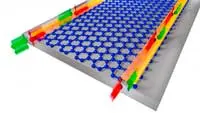Electronics News
Archive : 18 July 2017 год
 Semiconductor distributor BCD Microelectronics has announced its merger with Munich based Atlantik Elektronik. The new company will be named BCD-Atlantik and is to remain an independent company but will combine resources from both companies.
Semiconductor distributor BCD Microelectronics has announced its merger with Munich based Atlantik Elektronik. The new company will be named BCD-Atlantik and is to remain an independent company but will combine resources from both companies.
“Our merger with Atlantik Elektronik strengthens our position in the UK and Ireland and our joint product portfolio allows us to offer a Europe-wide sales network to support our growing international trade and increasing re-shoring,” comments Barry Coomber, managing director of BCD Microelectronics.
Atlantik Elektronik is a supplier of high technology components and specialise in design-in of innovative semiconductor products and semiconductor solutions, notably in the high-end markets.
BCD and Atlantik Elektronik provide technical solutions to customers from product definition, design phase through to full production and test.
The combined product portfolio of BCD and Atlantik will include not only semiconductors, including memory and microcontrollers, but also embedded systems, systems on modules, displays, audio and video processing, test equipment, lithium-ion batteries and wired and wireless connectivity solutions.
Author
Peggy Lee
Source: www.newelectronics.co.uk
.webp) A fast and inexpensive process for manufacturing supercapacitor electrode materials that meet stringent industrial demands has been developed by a team of engineers at the University of Washington. Applications include electric cars, wireless telecommunications and high powered lasers.
A fast and inexpensive process for manufacturing supercapacitor electrode materials that meet stringent industrial demands has been developed by a team of engineers at the University of Washington. Applications include electric cars, wireless telecommunications and high powered lasers.
"In industrial applications, time is money," said assistant professor Peter Pauzauskie. "We can make the starting materials for these electrodes in hours, rather than weeks. And that can significantly drive down the synthesis cost for making high performance supercapacitor electrodes."
"Supercapacitors can act much faster than batteries because they are not limited by the speed of the reaction or by-products that can form," doctoral student Matthew Lim added.
To get the high surface area for an efficient electrode, the team used aerogels, which were said to demonstrate a high surface area and extremely low density.
"One gram of aerogel contains about as much surface area as one football field," said Pauzauskie.
The team made the aerogels from a gel-like polymer, a material with repeating structural units, created from formaldehyde and other carbon-based molecules.
The researchers then treated molybdenum disulphide or tungsten disulphide with high frequency sound waves to break them up into thin sheets and incorporated them into the carbon-rich gel matrix.
After obtaining the dried, low-density aerogel, they combined it with adhesives and another carbon-rich material, which could be rolled out into sheets. They cut half-inch discs from the dough and assembled them into simple coin cell battery casings to test the material's effectiveness as a supercapacitor electrode.
According to the researchers, the electrodes had a capacitance of at least 127% greater than the carbon-rich aerogel alone.
The team believes their method to trap materials quickly in aerogels could be applied to high capacitance batteries or catalysis.
Author
Peggy Lee
Source: www.newelectronics.co.uk
 A topological insulator that can function at room temperature had been developed by physicists from the University of Wuerzburg.
A topological insulator that can function at room temperature had been developed by physicists from the University of Wuerzburg.
According to the researchers, all known topological insulators have to be cooled to very low temperatures – usually -270°C – to study the quantum properties of the edge channels.
"As the temperature of a topological insulator increases, all quantum effects are washed out and with them the special properties of the electrically conducting edges," Dr Jörg Schäfer explains.
"Of course, such conditions are not very practicable for potential applications such as ultra-fast electronics or quantum computers.”
To solve this problem, the physicists used a special combination of materials: an ultra-thin film consisting of a single layer of bismuth atoms deposited on a silicon carbide substrate.
"The crystalline structure of the silicon carbide substrate causes the bismuth atoms to arrange in a honeycomb geometry when depositing the bismuth film – very similar to the structure of the 'miracle material' graphene," Professor Ralph Claessen explains.
Because of this analogy, the waver-thin film is called ‘bismuthene’.
"Bismuthene forms a chemical bond to the substrate," said Professor Ronny Thomale. "Whereas common bismuth is an electrically conductive metal, the honeycomb monolayer remains a distinct insulator, even at room temperature and far above.”
The metallic electronic conduction channels which could be used for future data processing are located at the edge of the bismuthene.
"Such conduction channels are 'protected topologically'. This means they can be used to transmit information virtually without loss," Ralph Claessen says.
This approach could enable spintronics, according to the scientists.
Author
Peggy Lee
Source: www.newelectronics.co.uk

